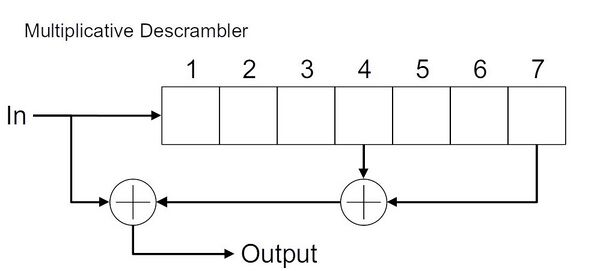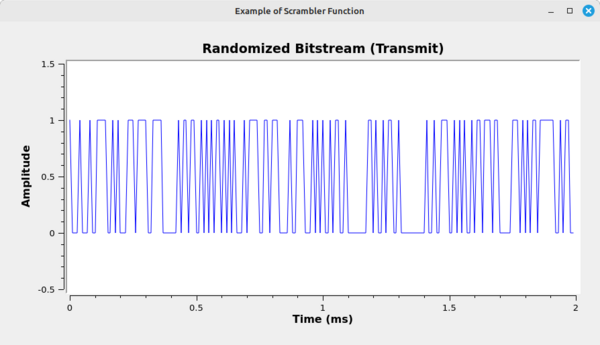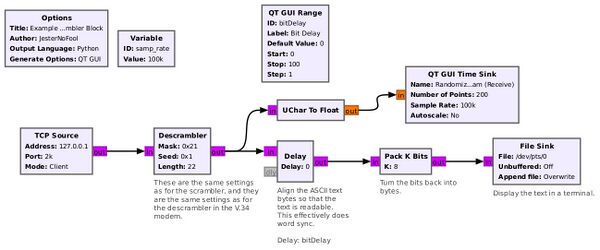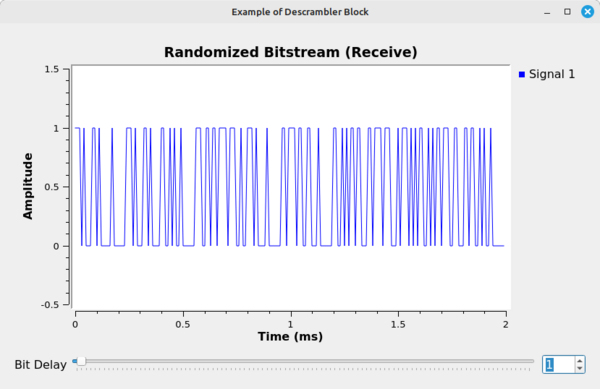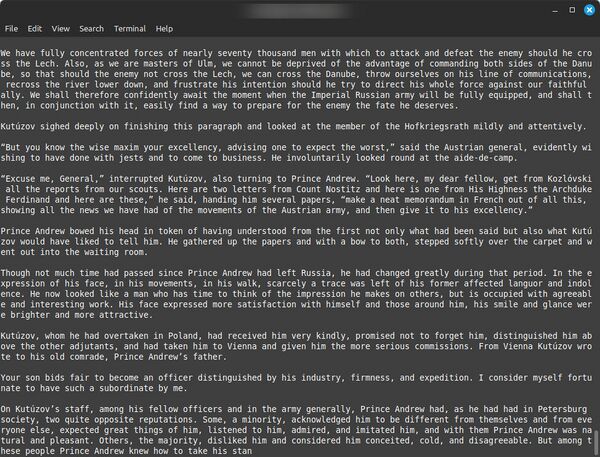Descrambler: Difference between revisions
Jesternofool (talk | contribs) (Added simple example for "Scrambler" and "Descrambler" blocks.) |
|||
| (One intermediate revision by the same user not shown) | |||
| Line 1: | Line 1: | ||
[[Category:Block Docs]] | [[Category:Block Docs]] | ||
[[Category:Pages with no Example Flowgraph]] | [[Category:Pages with no Example Flowgraph]] | ||
The '''Descrambler''' block is an implementation of a [https://en.wikipedia.org/wiki/Scrambler#Multiplicative_(self-synchronizing)_scramblers multiplicative descrambler]. It takes an input of bits as output by the [[Scrambler]] block and derandomizes the output. So long as the ''Mask'' and ''Length'' of the two blocks are identical, the '''Descrambler''' block will self-synchronize with the [[Scrambler]] block output. | |||
[[File:Multiplicative-descrambler-7-stage-diagram.jpg|600px]] | |||
''This is a block diagram of a multiplicative descrambler using a 7-stage linear feedback shift register (LFSR) with taps at (7,4).'' | |||
This block works at the bit level, mean this block works on the LSB only of the input data stream, i.e., on an "unpacked binary" stream. It produces the same format on its output. | |||
== Parameters == | == Parameters == | ||
; Mask | ; Mask | ||
: Polynomial mask for LFSR | : Polynomial mask for LFSR. This should be identical to the mask used in the [[Scrambler]] block. | ||
; Seed | ; Seed | ||
| Line 11: | Line 18: | ||
; Length | ; Length | ||
: Shift register length | : Shift register length. Must be <=63, meaning it can handle up to a polynomial of size 64. The ''Length'' will be one less than the polynomial size. Thus, a 7-stage LFSR (as shown in the block diagram above) would correspond to a polynomial of size 7, and the ''Length'' would be 6. | ||
== Example Flowgraph == | == Example Flowgraph == | ||
NOTE: This is the same example as used in the [[Scrambler]] block. | |||
Here is a simple example flowgraph. This flowgraph uses a text file as a source. The text file consists of [https://en.wikipedia.org/wiki/ASCII ASCII] characters, meaning 8-bit characters. | |||
[[File:ScramblerExampleFlowgraph.jpg|600px]] | |||
When the flowgraph is running, the following time domain display shows the randomized bitstream. | |||
[[File:ScramblerTimeDomainDisplay.png|600px]] | |||
The receiver is a separate flowgraph, as follows: | |||
[[File:DescramblerExampleFlowgraph.jpg|600px]] | |||
The [[Descrambler]] flowgraph takes in the bitstream, derandomizes it, and sends it on. The [[Delay]] block, once accurately set, ensures that the follow-on block will align with the byte boundary such that the ASCII text will be readable. | |||
[[File:DescramblerTimeDomainDisplay.png|600px]] | |||
Once the delay is properly set, the terminal outputs the readable text: | |||
[[File:NovelTextfromDescrambler.jpg|600px]] | |||
== Source Files == | == Source Files == | ||
Latest revision as of 00:45, 26 July 2025
The Descrambler block is an implementation of a multiplicative descrambler. It takes an input of bits as output by the Scrambler block and derandomizes the output. So long as the Mask and Length of the two blocks are identical, the Descrambler block will self-synchronize with the Scrambler block output.
This is a block diagram of a multiplicative descrambler using a 7-stage linear feedback shift register (LFSR) with taps at (7,4).
This block works at the bit level, mean this block works on the LSB only of the input data stream, i.e., on an "unpacked binary" stream. It produces the same format on its output.
Parameters
- Mask
- Polynomial mask for LFSR. This should be identical to the mask used in the Scrambler block.
- Seed
- Initial shift register contents
- Length
- Shift register length. Must be <=63, meaning it can handle up to a polynomial of size 64. The Length will be one less than the polynomial size. Thus, a 7-stage LFSR (as shown in the block diagram above) would correspond to a polynomial of size 7, and the Length would be 6.
Example Flowgraph
NOTE: This is the same example as used in the Scrambler block.
Here is a simple example flowgraph. This flowgraph uses a text file as a source. The text file consists of ASCII characters, meaning 8-bit characters.
When the flowgraph is running, the following time domain display shows the randomized bitstream.
The receiver is a separate flowgraph, as follows:
The Descrambler flowgraph takes in the bitstream, derandomizes it, and sends it on. The Delay block, once accurately set, ensures that the follow-on block will align with the byte boundary such that the ASCII text will be readable.
Once the delay is properly set, the terminal outputs the readable text:
Source Files
- C++ files
- TODO
- Header files
- TODO
- Public header files
- TODO
- Block definition
- TODO
